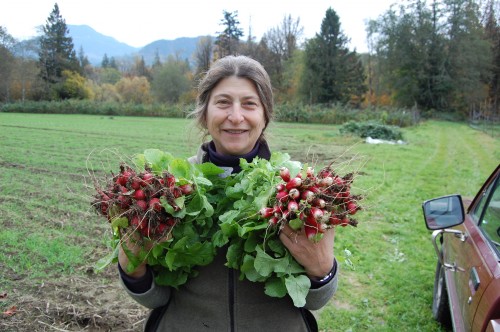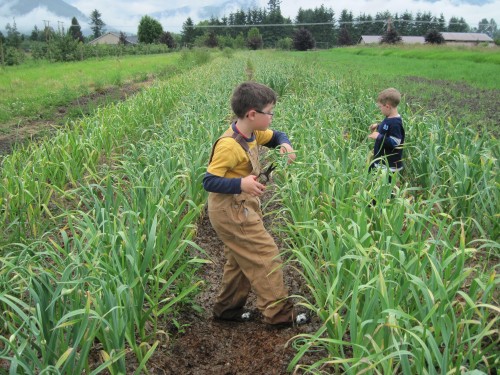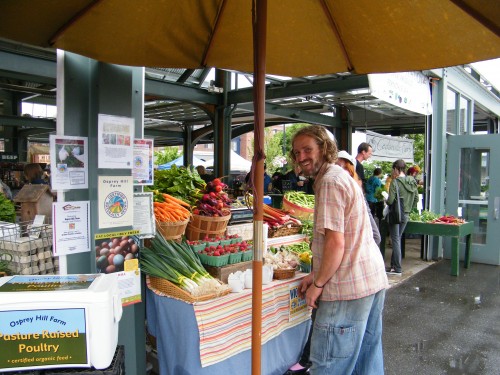Some Food Considerations
 [We are excited to publish the fourth piece in our Foodshed Series, with monthly updates from the amazing chefs working hard to provide program participants and staff at the Environmental Learning Center with sustainable, seasonal, and deliciously fresh food. In an age where the production and consumption of food are heavily disconnected, North Cascades Institute works hard to preserve those ties by considering how food flows from the farms to our tables and all the processes in between. Purchasing from local farmers allows us to draw connections between their livelihoods and our own while at the same time contributing to our mission to conserve Northwest environments through education. Learn more about our Foodshed Initiative on our website at www.ncascades.org/foodshed]
[We are excited to publish the fourth piece in our Foodshed Series, with monthly updates from the amazing chefs working hard to provide program participants and staff at the Environmental Learning Center with sustainable, seasonal, and deliciously fresh food. In an age where the production and consumption of food are heavily disconnected, North Cascades Institute works hard to preserve those ties by considering how food flows from the farms to our tables and all the processes in between. Purchasing from local farmers allows us to draw connections between their livelihoods and our own while at the same time contributing to our mission to conserve Northwest environments through education. Learn more about our Foodshed Initiative on our website at www.ncascades.org/foodshed]
When I first began working at the Environmental Learning Center, I believed I already had a good understanding of food issues. It started in college when I wrote a paper on genetically altered foods (1988!). I thought I knew how to cook healthy meals, and was doing better than most. Like a fool, I thought a carrot was a carrot was a carrot. Chicken was better than beef. Today I know that I was hardly even scratching the surface. Barely a week goes by now that I do not learn of another issue to look into when it comes to food. Below, I’d like to share the some of the questions I consider and the process I go through when evaluating the quality and sustainability of foods to purchase for the Environmental Learning Center kitchen.
The two largest issues that I deal with are getting the food up to the Environmental Learning Center, and working within a budget. I wrote about the process of bringing food up the Skagit Valley in my last blog. I will not start in on the economy! It is a challenge deciding what is most important to spend money on. I prioritize for fresh produce and protein. They are the two most important additions to a meal, and I believe you get the most for your money. The factors I consider are (in no particular order): sustainable, healthy, ethical, and local.
Seafood. I only buy wild caught, except oysters. Fish farming is harmful to the waters. They dump antibiotics and hormones into the water that can travel thousands of miles. They also genetically alter the fish to make them bigger and more colorful. As a consumer, it is important to ask whether the fish stock is healthy or overfished. Are the fishermen making a living wage? I buy my salmon from Nerka Salmon Frozen at Sea. It is a family-owned business that handles everything from catching to selling. The boat is a troller out of Bellingham, which has the least impacts on the environment and sustains the best quality of product. I also choose to cook Pollock because not only did I used to fish for it in my by-gone fishing days, but I know that it is heavily regulated and sustainable.
 Grass-fed livestock at Nooksack Delta Ranch enjoy a day in the fields. Photo by Nooksack Delta Ranch.
Grass-fed livestock at Nooksack Delta Ranch enjoy a day in the fields. Photo by Nooksack Delta Ranch.
Beef. Ninety percent of the beef I use is ground from Nooksack Delta Ranch in Ferndale, Washington. It is free range and grass fed. Leah, one of the owners, rotates her cows around to promote grass growth and not over work the land. She also sells directly to consumers rather than a middleman such as a distributor so that she can make a better living and maintain the quality of her product. When cows are grass fed they actually have more nutritional value and are loaded with Omega-3s. I avoid corn fed beef, as cows do not normally eat corn because it destroys the inside of their digestive tracts. The majority of beef sold today comes from livestock that are penned up after the first six months of their lives. These huge animal factories are also one of the biggest polluters of industrial runoff into our rivers and stream systems today. Do not get fooled by organic beef. This simply means that cows are fed organic corn. Always buy free range! If it does not say free range at the least, it has not been raised ethically or in an environmentally friendly way. Best yet, find a local rancher, see for yourself how he treats his cows, and buy half a side.
Chicken. I get my fowl from Osprey Hill Farm in Acme. They use the chicken poop (Yes, I said poop!) to fertilize their produce. They also grow their own feed. It is one big circle, and it does not get anymore organic then that. I love visiting Osprey Hill Farm, as they have beautiful land and are the nicest people around. If you have a chance to stop by, get them to tell you the story of how they got into organic farming.
 Children explore fields of alliums.
Children explore fields of alliums.
Produce. I get the majority of my produce from Blue Heron Farm, Viva Farms, Jones Creek Farm, and Osprey Hill Farm. I know these farmers, I know their farms, and I know their families. Most important I know how they farm. How healthy their land is, what kind of seed they use, and how they treat their workers.
When it comes to sustainability, I am not just worried about abundance of the item. I wonder how the land is holding up. Where do the farms get their water? Do they use seed crop or buy from Monsanto? When produce is being prepared for shipping and packaging, is it put in a box, in a box, in a box? Is it wrapped in plastic? Ethical farming encompasses not just how a business treats its workers, animals, customers, and the land, (but the mentality with which they do it.)
Before ordering any food, I now ask whether I would want North Cascades Institute program participants to put this food in their bodies. The fresher a food is, the more nutritional it is going to be. Has anything been altered? Added? Manipulated? Has it been processed and transported safely? How long ago was it picked from the fields?
 Osprey Hill Farm sells produce and poultry at the Farmers Market in Bellingham, WA. Photo by Osprey Hill Farm.
Osprey Hill Farm sells produce and poultry at the Farmers Market in Bellingham, WA. Photo by Osprey Hill Farm.
Ultimately, it is about defining the concept of local food. This is always a question up for big debate, and many would argue that it depends on where you live. One hundred or two hundred miles away? Just Washington, or Idaho and Oregon too? The West Coast? In my opinion, the closer to you the better. This is one of my biggest considerations when deciding where to purchase my food. Here at the Environmental Learning Center, we teach our Mountain School students that we purchase local for three reasons: To cut down on our carbon footprint, to build and protect our communities by supporting our neighbors and farmlands, and to get the best tasting and most nutritional food that we can.
I hope you did not think I was going to tell you exactly what to spend your money on when it comes to food. I just wanted to get you all thinking. Oh, that local tomato. It could have been picked, shipped out of state, sorted, packed, and shipped back. So, research your supplier too.
Leading photo of Anne Shwartz, owner of Blue Heron Farm, holding two bunches of radishes fresh from the field, by Mike Cuseo.


Great article Shelby. It’s good to be reminded that the choices we make every week at the grocery (or farm or market or fruit stand) really matter.
Thank you so much for writing this, Shelby. Beautifully written with a strong, important message. I appreciate you for helping to educate others about these critical issues.